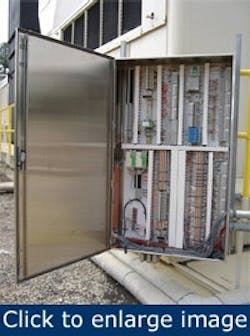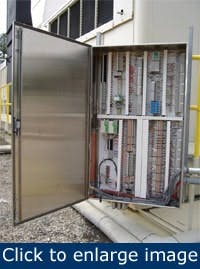Remote monitoring through turbine retrofit
When a large Southern utility dusted off a fleet of unused combustion gas turbine engines to modernize them for generating backup electricity during peak energy-consumption periods, it called on project developer HPI LLC (www.hpi-llc.com) to upgrade the control systems. HPI supplied a standardized, digital control system offering improved reliability, enhanced turbine control and diagnostics information, and remote start capabilities.
HPI specializes in providing retrofit controls for gas and steam turbine power generation, compressors and mechanical drive systems. The company opened its doors in 2002. Its team of engineers and technicians have completed more than 70 gas turbine models for more than 20 manufacturers.
Remote, panel-mounted control systems for four General Electric MS5001 turbo-generator packages include vibration, speed and temperature-monitoring modules.
Four General Electric MS5001 (Frame 5) turbo-generator packages were fitted with Allen-Bradley ControlLogix controllers. HPI chose ControlLogix for its ability to integrate discrete, motion, process control, batch, drive systems and safety using a single development environment and a single, open communication protocol. “We used to buy separate controllers and wire them together, but the Rockwell Automation Logix controller allows us to provide turnkey solutions that go beyond just the gas turbine control,” says Jerry Wheelwright, vice president of engineering, HPI.
For networking and visualization, HPI networked Allen-Bradley FLEX I/O modules with copper and fiberoptic ControlNet and EtherNet/IP network communications. The remote, panel-mounted control system includes digital, analog and temperature-monitoring modules. The terminals, fuses, relays and conduits were preinstalled in subpanels to reduce the amount of on-site wiring.
The utility can operate the system from a remote site five miles away. Engineers also developed a live feed from explosion-proof cameras within the turbine enclosure at other customer facilities.
“The ability to monitor and control the turbines at any time of the day from a remote location is a significant benefit to this customer,” Wheelwright says. “The utility can have gas turbines spread around the state and run the controls through larger steam turbine plants that are manned 24 hours a day, helping to eliminate the need to staff each individual site.”
[pullquote]To reduce the condition-monitoring system costs, the utility wanted to retain the existing vibration probes, so HPI used Rockwell Automation XM-120 dynamic measurement modules. Two of the two-channel modules on each of the four turbines interface with the equipment via ControlNet to DeviceNet interface modules.
In retrofit situations, HPI’s customers typically have an overspeed protection system that is either obsolete or hydraulic, which makes the system difficult to test and maintain. For the Southern utility project, HPI replaced the overspeed protection systems with XM-220 dual-speed modules. The XM-220 module is an intelligent, two-channel measurement module that accepts input from two tachometers. The module measures speed, rotor acceleration and peak speed and is capable of detecting zero speed, locked rotor and reverse rotation.
The turbines haven’t experienced a start failure since the control upgrade. HPI was pleased with the flexibility of the XM series, the ease of configuration and the ability to see that the protective circuits are working, and decided to standardize on the equipment for future upgrades.
“We chose the XM series for two reasons,” says Wheelwright. “One was availability. It was on the shelf when we needed it. The second reason was its ability to interface with other probes and the rest of the system.”

